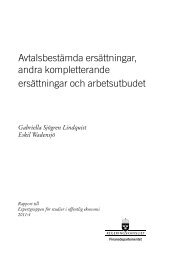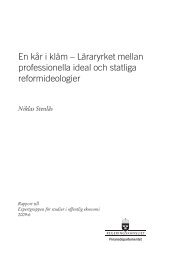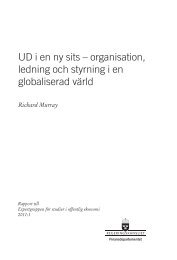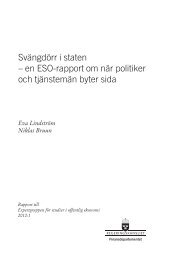Läs rapporten här - Expertgruppen för Studier i Offentlig ekonomi
Läs rapporten här - Expertgruppen för Studier i Offentlig ekonomi
Läs rapporten här - Expertgruppen för Studier i Offentlig ekonomi
You also want an ePaper? Increase the reach of your titles
YUMPU automatically turns print PDFs into web optimized ePapers that Google loves.
Summary<br />
The cost-benefit method is robust<br />
Public funds are limited and should be spent where the highest<br />
benefits can be achieved. For this reason the Swedish transport<br />
investment policy is based on cost-benefit analysis (CBA)<br />
complemented with other types of decision support. CBA is a<br />
means to systematically compare benefits and costs. Central to all<br />
cost-benefit analyses is that two alternative scenarios are designed<br />
for the analyzed period: the investment scenario and the noinvestment<br />
scenario. In the no-investment scenario, it is assumed<br />
that the transport system does not include the evaluated<br />
investment. In the investment scenario, it is assumed that the<br />
transport system includes the evaluated investment.<br />
In this report, we undertake a CBA for the Stockholm Metro<br />
applying current Swedish methodology, models and established<br />
national guidelines. The CBA is made for the current Stockholm<br />
Metro, as if the analysis was undertaken in the 1950s (when the<br />
current Metro was built) and as if the methods and models<br />
presently used for CBA in Sweden had been available and used at<br />
the time.<br />
We use different assumptions in the no-investment scenario. In<br />
one analysis we assume that no other public transport<br />
infrastructure had been built. In another no-investment scenario<br />
we assume that the tram that run along the same corridors as the<br />
Metro now does would have persisted. We also vary the<br />
construction cost assumption. The CBA is carried out using i)<br />
actual construction cost from the 1950s and ii) an estimate of what<br />
the cost had been today. We also estimate the long-term effects on<br />
the labor market in terms of income growth and on the land-use<br />
patterns, which are not included in the standard CBA. The CBA<br />
shows a positive outcome for the Metro, and hence that the<br />
13








